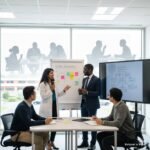
Sustainable innovation (SI) is not just a buzzword; it’s a fundamental shift in the way industries, governments, and individuals approach development. It involves creating solutions that meet current needs without compromising the ability of future generations to meet theirs. This concept combines environmental responsibility with business growth and social progress.
In this article, we will explore the concept of sustainable innovation, its framework, types, examples, and ideas. Whether you are looking for an introduction to sustainable innovation or seeking information on different types of sustainable innovations and frameworks, this guide is designed to provide a comprehensive view.
What is Sustainable Innovation?
Sustainable innovation (SI) can be defined as the development of new products, services, or processes that offer significant environmental and social benefits compared to existing alternatives. Unlike traditional innovations that may focus primarily on profitability or efficiency, sustainable innovations balance economic growth with ecological integrity and social well-being.
A clear example of SI is the development of renewable energy technologies, such as solar panels or wind turbines. These innovations help reduce carbon emissions, offering an alternative to fossil fuels and promoting the use of clean energy.
Key elements that define sustainable innovation include:
- Environmental Impact: Reducing negative environmental effects, such as pollution or resource depletion.
- Economic Viability: Ensuring the innovation is commercially viable and can sustain growth.
- Social Responsibility: Considering broader social implications, such as worker conditions, community health, and global equity.
The Importance of Sustainable Innovation
In recent decades, governments and companies have placed more emphasis on innovations that can reconcile economic, social, and environmental goals to achieve a “win-win-win” outcome (Afeltra et al., 2023). Thus, practicing sustainable innovation is a significant step for global survival in a competitive environment, for an economy or business community (Naveed et al., 2023), in a world facing unprecedented environmental challenges, such as climate change, resource scarcity, and social inequality. By embedding sustainability at the core of innovation processes, companies and organizations can reduce their ecological footprint while contributing to long-term prosperity.
Adomako y Nguyen (2023) highlight that a company’s level of co-innovation behaviors is positively associated with sustainable innovation. Meanwhile, findings from the study by Taghizadeh et al., (2024) reveal that the sustainable innovation performance of SMEs is strongly influenced by the synergy of learning, integration, and coordination capabilities.
Moreover, as consumers increasingly prefer eco-friendly products and services, companies that prioritize sustainable innovation gain a competitive edge. In sectors like energy, agriculture, and manufacturing, sustainable innovations help organizations comply with regulatory requirements, reduce costs through efficiency, and attract environmentally-conscious customers.
Types of Sustainable Innovation
Understanding the types of sustainable innovations is essential for understanding how different sectors apply these principles. They can be classified into three key areas:
- Product Innovation: Involves creating new sustainable products or significantly improving existing ones. For example, electric vehicles (EVs) represent a product innovation aimed at reducing greenhouse gas emissions.
- Process Innovation: Companies also innovate in how products are manufactured by using cleaner production methods. Sustainable process innovations may include adopting energy-efficient manufacturing techniques or circular economy models that reduce waste through recycling and material reuse.
- Business Model Innovation: This type of innovation transforms the core business model to integrate sustainability. A popular example is the sharing economy, where companies like Uber or Airbnb offer access to services without ownership, reducing waste and resource use.
Sustainable Innovation Framework
The sustainable innovation framework provides a structured approach to fostering and measuring sustainability in innovation. Various models exist, but they generally involve key stages like idea generation, development, and implementation, all supported by sustainability principles.
One popular framework is the Triple Bottom Line (TBL) approach, which focuses on three pillars:
- Environmental Stewardship: Ensuring innovations minimize ecological harm and promote sustainability.
- Social Equity: Addressing the social implications of innovations, such as job creation, community health, and equitable resource access.
- Economic Prosperity: Ensuring innovations remain profitable and contribute to economic growth.
Another relevant framework is Cradle to Cradle, which focuses on creating closed-loop systems where waste is continuously reused, mimicking natural ecosystems where resources are indefinitely recycled. Meanwhile, Rahardjo et al., (2024) propose a new sustainable innovation framework (SIF) that uses inductive and integrative approaches based on Lean Six Sigma (LSS) methodology and Industry 5.0 technologies.
Examples of Sustainable Innovation
There are numerous examples of SI across various industries. One example is Patagonia, an outdoor clothing brand known for its commitment to environmental sustainability. Patagonia has pioneered the use of recycled materials in its products and actively promotes environmental care and repair through its Worn Wear initiative.
In the energy sector, Tesla has revolutionized the automotive industry by producing electric vehicles that drastically reduce carbon emissions. Its commitment to sustainability extends beyond cars to solar energy products, providing comprehensive solutions for energy efficiency.
Another example of SI is the Zero Waste movement adopted by companies like Unilever, aiming to eliminate waste in their manufacturing processes.
Sustainable Innovation Ideas
Are you looking for sustainable innovation ideas to inspire the next big breakthrough? Here are some cutting-edge concepts that are making waves across industries:
- Circular Economy Initiatives: Involves redesigning products and processes to eliminate waste. An example is companies investing in biodegradable packaging or implementing recycling programs that close the product life cycle.
- Carbon Capture Technologies: Innovations such as Carbon Capture and Storage (CCS) are gaining traction. These systems capture CO2 emissions from industrial activities and store them underground, preventing their release into the atmosphere.
- Smart Grids and Renewable Energy Storage: Innovations in energy grids, such as smart meters or advanced battery storage, allow for more efficient use of renewable energy sources like wind and solar.
- Sustainable Agricultural Practices: From vertical farming to precision agriculture, innovators are finding ways to use less land, water, and pesticides while increasing food production.
- Eco-Friendly Building Materials: Eco-friendly building materials like recycled concrete, bamboo, and sustainable insulation are becoming increasingly popular in the architecture world.
- Biodegradable Plastics: Innovations in material science are producing plastics that degrade more quickly and with less environmental impact compared to traditional plastic products.
On the other hand, Ardito (2023) highlights that a company’s level of digitalization affects the likelihood of launching sustainable innovations through the alignment between digital technology and business (Lin y Mao, 2024). Therefore, if you want to drive sustainable innovations, your organization should adopt digital technology (e.g., artificial intelligence, cloud computing, robotics, smart devices, big data analytics, 3D printing, high-speed infrastructure, and blockchain).
Why Sustainable Innovation Is More Important Than Ever
According to Cillo et al., (2019), to fulfill the concept of sustainable development, companies are increasingly expected to develop innovations that reconcile economic, environmental, and social goals — that is, sustainable innovations.
In this sense, the urgent need for SIs arises from growing environmental and social challenges. Companies and governments are recognizing that sustainability is no longer a luxury; it is a necessity for long-term survival. Global warming, resource depletion, and population growth put enormous pressure on ecosystems and economies.
Through sustainable innovation, organizations can reduce their environmental footprint, comply with regulatory requirements, and attract a growing base of eco-conscious consumers. Likewise, Ghobakhloo et al., (2021) highlight that Industry 4.0 has some functions that improve green process innovation capabilities and the ability to economically and competitively develop or reintroduce green products. Similarly, Wang et al., (2023) concluded that companies with digital platform capabilities perform better in sustainability-oriented innovation.
Adomako y Tran (2024) investigated the impact of R&D support on SI in 220 companies in Vietnam and found the following:
- R&D support positively impacts green technology transfer,
- Green technology transfer mediates the relationship between R&D support and SI, and
- The influence of green technology transfer on sustainable innovation is enhanced by a company’s commitment to environmental ethics.
Meanwhile, Afeltra et al. (2023) systematized the scientific literature on Sustainable Innovation as a broad field to identify the most relevant academics and their significant contributions, as well as existing research lines, and identified five main themes:
- The role of Regulation, Market, and Technology;
- Determinants of Eco-Innovation and firm-specific factors, and the debate between corporate environmental performance and corporate financial performance;
- Green innovation and internal and external factors;
- Strategic determinants of green (non-green) innovation; and
- The interaction between policies, regulations, and green innovation.
Finally, for both individuals and companies, adopting sustainable practices ensures that innovation not only benefits the bottom line but also contributes positively to society and the environment. It’s not just about what we build; it’s about how we build it and who benefits from the outcomes.
Conclusion
Sustainable innovation is more than a trend; it is a transformative approach to creating a better world. Whether through product innovations, sustainable business models, or the sustainable innovation framework, the goal is to align progress with ecological balance and social equity.
The future is bright for SI as more companies recognize that long-term success depends on integrating sustainability at every stage. By following examples of sustainable innovations and harnessing new sustainable innovation ideas, companies can lead the way in creating a resilient, prosperous, and equitable future for all.
References
Adomako, S., & Nguyen, N. P. (2023). Co-innovation behavior and sustainable innovation in competitive environments. Sustainable Development, 31(3), 1735-1747. https://doi.org/10.1002/sd.2479
Adomako, S., & Tran, M. D. (2024). Exploring the effect of R&D support, green technology transfer, sustainable innovation. Sustainable Development, 32(5), 4758-4769. https://doi.org/10.1002/sd.2936
Afeltra, G., Alerasoul, S.A. and Strozzi, F. (2023), “The evolution of sustainable innovation: from the past to the future“, European Journal of Innovation Management, Vol. 26 No. 2, pp. 386-421. https://doi.org/10.1108/EJIM-02-2021-0113
Ardito, L. (2023). The influence of firm digitalization on sustainable innovation performance and the moderating role of corporate sustainability practices: An empirical investigation. Business Strategy and the Environment, 32(8), 5252-5272. https://doi.org/10.1002/bse.3415
Cillo, V., Petruzzelli, A. M., Ardito, L., & Giudice, M. D. (2019). Understanding sustainable innovation: A systematic literature review. Corporate Social Responsibility and Environmental Management, 26(5), 1012-1025. https://doi.org/10.1002/csr.1783
Ghobakhloo, M., Iranmanesh, M., Grybauskas, A., Vilkas, M., & Petraitė, M. (2021). Industry 4.0, innovation, and sustainable development: A systematic review and a roadmap to sustainable innovation. Business Strategy and the Environment, 30(8), 4237-4257. https://doi.org/10.1002/bse.2867
Lin, J., & Mao, M. (2024). How does digital transformation affect sustainable innovation performance? The pivotal roles of digital technology-business alignment and environmental uncertainty. Sustainable Development, 32(4), 3163-3181. https://doi.org/10.1002/sd.2830
Naveed, A., Zhuparova, A., Ahmad, N., & FathollahZadeh Aghdam, R. (2023). Sources of information on sustainable innovation: a citation-based systematic literature review and content analysis. Total Quality Management & Business Excellence, 34(9–10), 1126–1151. https://doi.org/10.1080/14783363.2022.2157713
Rahardjo, B., Wang, FK., Lo, SC. et al. A Sustainable Innovation Framework Based on Lean Six Sigma and Industry 5.0. Arab J Sci Eng 49, 7625–7642 (2024). https://doi.org/10.1007/s13369-023-08565-3
Taghizadeh, S.K., Rahman, S.A., Nikbin, D., Radomska, M. and Maleki Far, S. (2024), “Dynamic capabilities of the SMEs for sustainable innovation performance: role of environmental turbulence“, Journal of Organizational Effectiveness: People and Performance, Vol. 11 No. 4, pp. 767-787. https://doi.org/10.1108/JOEPP-04-2023-0166
Wang, N., Wan, J., Ma, Z., Zhou, Y., & Chen, J. (2023). How digital platform capabilities improve sustainable innovation performance of firms: The mediating role of open innovation. Journal of Business Research, 167, 114080. https://doi.org/10.1016/j.jbusres.2023.114080
Editor and founder of “Innovar o Morir” (‘Innovate or Die’). Milthon holds a Master’s degree in Science and Innovation Management from the Polytechnic University of Valencia, with postgraduate diplomas in Business Innovation (UPV) and Market-Oriented Innovation Management (UPCH-Universitat Leipzig). He has practical experience in innovation management, having led the Fisheries Innovation Unit of the National Program for Innovation in Fisheries and Aquaculture (PNIPA) and worked as a consultant on open innovation diagnostics and technology watch. He firmly believes in the power of innovation and creativity as drivers of change and development.





